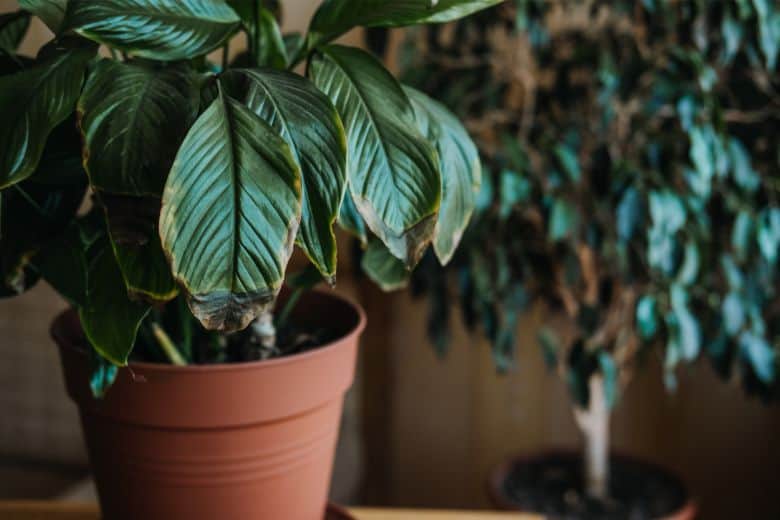
Canna lilies are a popular garden flower that are loved for their big, bold foliage and showy blooms. Unfortunately, their leaves can sometimes start to turn brown, which can be a cause for concern for gardeners.
There are several possible causes for brown leaves on cannas, ranging from environmental factors such as extreme temperatures or too much sun, to pests and diseases.
In this article, we will discuss the potential causes of brown leaves and how to address them. By understanding the cause of the browning leaves, you can take the appropriate steps to help your cannas stay healthy and beautiful.
Causes of Browning Leaves in Canna Lilies
Canna lilies are a beautiful and exotic plant species that can liven up any garden. However, some gardeners may find that their lilies are beginning to brown or yellow.
This can be caused by a variety of factors, such as over-watering, too much direct sunlight, nutrient deficiencies, or disease.
Understanding the possible causes of browning leaves in canna lilies can help gardeners identify the problem and take the appropriate steps to restore their plants to health.
Understanding the Plant’s Environment
The environment is a key factor in the health and growth of plants. A plant’s environment can include air, soil, water, and light. Understanding the environment of a plant is essential to ensure it is getting the best possible growing conditions.
Air quality affects the amount of oxygen a plant can absorb, and can be influenced by humidity. Soil composition affects the amount of nutrients a plant receives, and the type of soil will determine the type of plant that can grow in it. Water is essential to all plants, as it transports nutrients and helps keep the soil moist.
Light is important for photosynthesis, and the intensity and duration of light can affect the type of plant and how much it grows. By understanding the environment of a plant, you can ensure it is receiving the right conditions for optimum growth.
Diagnosing the Problem
Identifying the Reasons Behind Brown Leaves on Your Canna Lily
- Improper Watering: Canna lilies prefer a consistently moist environment. However, overwatering can cause problems such as root rot, which often manifests as yellowing or browning leaves. Conversely, underwatering can cause the leaves to dry out and turn brown. Striking a balance in watering is essential to the plant’s health.
- Sunburn: Canna lilies love the sun but exposure to intense sunlight for extended periods can cause leaf burn, resulting in brown or scorched patches. If your plants are exposed to harsh afternoon sunlight, this could be causing the browning.
- Nutrient Deficiency: Canna lilies have high nutrient requirements, particularly for potassium and magnesium. A deficiency in these nutrients can cause browning of leaves. Use a well-balanced plant fertilizer to resolve nutrient deficiencies.
- Inadequate Drainage: Canna lilies don’t tolerate waterlogged conditions, which can lead to root rot and ultimately cause the leaves to turn brown. Ensure your plant has good drainage to prevent this issue.
- Disease and Pests: Canna lilies can be affected by several pests and diseases, such as canna leaf rollers and rust fungus, which can cause browning or spotting on the leaves. If you see unusual patterns or spots, this might be the cause.
- Temperature Stress: Canna lilies are tropical plants and can suffer if temperatures drop too low. Cold, windy conditions can cause the leaves to dry out and turn brown.
- Transplant Shock: If you have recently transplanted your canna lily, the plant could be undergoing shock, a common cause for leaf browning. Ensure you’re providing the right care to help it adjust to the new environment.
Each of these issues has different solutions, so accurately diagnosing the problem is key to restoring your canna lily to health.
Preventing Further Browning
- Correct Watering Practices: Maintain a balanced watering routine to keep the soil moist but not waterlogged. In hot weather, water more frequently but avoid over-saturating the soil.
- Proper Sunlight Exposure: Although canna lilies enjoy sunlight, ensure they’re not exposed to harsh, direct sunlight for extended periods. Provide some shade during the hottest part of the day, especially in summer, to prevent sunburn.
- Nutrient Management: Apply a well-balanced plant fertilizer to the soil around your canna lilies to provide essential nutrients. Follow the application instructions provided on the product.
- Ensure Adequate Drainage: Plant your canna lilies in well-draining soil and check that the pot or garden bed allows excess water to escape. This prevents waterlogging and root rot.
- Disease and Pest Control: Regularly inspect your canna lilies for signs of pests or diseases. If you notice any, promptly treat them with an appropriate pesticide, fungicide, or other treatment.
- Proper Temperature Maintenance: Protect your canna lilies from temperature extremes. In cold weather, consider moving pots indoors or covering garden plants with a frost blanket.
- Careful Transplanting: If you need to transplant your canna lilies, do so with care to minimize stress. Transplant in cooler weather and water thoroughly after moving.
- Prune Affected Leaves: If you see a leaf that’s already turning brown, it’s often best to prune it. This helps to prevent potential spread of disease and allows the plant to focus its energy on new growth.
By taking these preventative measures, you can help maintain the health of your canna lilies and avoid further browning of the leaves.
Treating Brown Leaves
Brown leaves are a common problem for gardeners. In order to treat them, there are several methods that gardeners can use.
- Adjust Watering Practices: If the browning is due to either underwatering or overwatering, adjust your watering habits. The soil should be kept moist, but not waterlogged. Adjust based on the weather and the plant’s needs.
- Relocate the Plant: If sunburn is causing the leaves to brown, relocate your canna lily to a location that gets plenty of sunlight but is protected from the harsh afternoon sun.
- Apply Fertilizer: In case of nutrient deficiency, apply a balanced plant fertilizer that includes necessary nutrients like potassium and magnesium. Follow the instructions on the fertilizer package to determine how much to apply.
- Improve Drainage: If poor drainage is the problem, consider repotting the plant with a better-draining soil mixture or improve the drainage in your garden bed. The soil should be moist, but it should not hold standing water.
- Treat Diseases and Pests: Treat any identified diseases or pests with an appropriate fungicide or pesticide. For example, for a fungal disease, a fungicide is required, while pests may require a pesticide. Follow the instructions on the product package for application details.
FAQs About the Why Are My Canna Lily Leaves Turning Brown
What causes Canna Lily leaves to turn brown?
Answer: The most common cause of Canna Lily leaves turning brown is too much sun or heat. If the plants are exposed to direct sunlight for too long, the leaves can burn and turn brown. Inadequate watering and poor soil drainage can also cause browning.
How can I prevent my Canna Lily leaves from turning brown?
Answer: To prevent browning, make sure to plant your Canna Lilies in a spot with partial shade, and water them regularly. If the soil is well-draining, this will prevent the roots from rotting due to overwatering.
Is it normal for the older leaves of my Canna Lily to turn brown?
Answer: Yes, it is normal for the older leaves of a Canna Lily to turn brown as the plant matures. This is usually nothing to worry about as long as the newer leaves are still healthy and green.
Conclusion
In conclusion, browning of Canna Lily leaves can be caused by a number of factors, including water stress, nutrient deficiency, sunburn, and pest infestations. Fortunately, these issues can usually be fixed by providing the plant with the proper care and attention. A thorough inspection of the plant and its environment is the best way to determine the cause and take the necessary steps to restore the plant to health.





